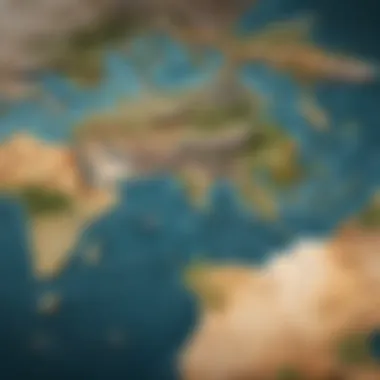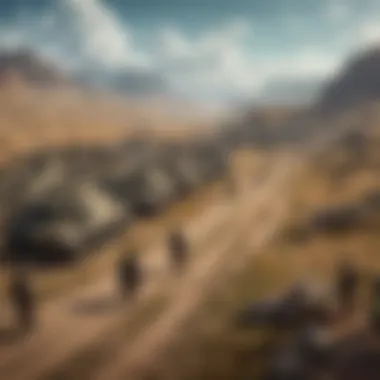Tim Marshall: Geography's Role in Political Power


Intro
In the realm of politics, geography often plays the role of a silent yet formidable partner. Tim Marshall, through his book Prisoners of Geography, effectively paints a picture of how physical landscapes mould the behaviours and decisions of nations. Rather than stay confined within the conventional walls of political theory, he invites us to step outside and see how rivers, mountains, and even deserts shape the fate of countries.
As the world evolves and borders shift, understanding the geographical constraints on political power remains more crucial than ever. Marshall argues that geography is not just about maps or borders, but also about resources and strategic advantages. This article aims to sift through these insights and demonstrate how geographical elements continuously influence international relations, and how they have historically steered nations into conflict or cooperation.
Book Categories
In the context of this discussion, Tim Marshall’s work fits into two primary categories.
- Non-Fiction: As an analytical piece providing insight into real-world scenarios, it helps readers understand complex geopolitical issues.
- Political Science: It discusses the implications of geographical factors on political strategies and decisions across different regions.
While it may not belong strictly to fiction or personal development, it undeniably proffers growth in understanding the intricacies of global politics.
Key Insights from Prisoners of Geography
A few key insights from the book unfold as follows:
- Boundaries Are Not Just Lines: Borders are often seen as mere demarcations on a map, but they tell stories of conflict, identity, and historical struggle. Marshall illustrates how these lines can dictate power dynamics, revealing that nations are much like chess pieces on a board, constrained by their positions.
- Natural Resources Shape Power Struggles: Resources influence not only the wealth of nations but also their political power. Oil, gas, and water have often been at the centre of conflicts—think of the Middle East, where resources have dictated political alliances and enmities.
- Climate as a Factor: Climate impact on agricultural productivity influences food security, migration patterns, and political stability. The tropic regions and temperate zones may find themselves on different political battlefields owing to their climatic endowments.
How to Apply the Lessons
Understanding the relationship between geography and politics can empower individuals and institutions alike. Here are a few ways one might apply these lessons in their own context:
- Education: Teaching new generations about geopolitical concepts can foster more informed future leaders.
- Policy Development: Policymakers can incorporate geographical considerations when drafting policies, ensuring that they address the unique needs and constraints of various regions.
- Conflict Resolution: Recognizing the geographical roots of disputes can lead to more effective diplomatic resolutions.
Prelims to Tim Marshall's Perspective
Understanding the intricate relationship between geography and political power isn't merely academic; it shapes the world in which we live today. Tim Marshall, through his insightful work, particularly Prisoners of Geography, brings these concepts to the forefront. His perspective challenges readers to reconsider how borders, natural resources, and geographical landscapes influence political decisions and international relations.
Marshall’s arguments underscore the reality that geographical factors are not just elements on a map; they are powerful determinants that can dictate the fate of nations. By grounding political power within a geographical context, he provides a framework for analyzing global events with a fresh lens—one that stresses the complex interplay of terrain, climate, and resource availability.
The significance of this viewpoint rests on its implications for current and future geopolitical strategies, fostering an awareness of how historical legacies and geographical limitations continue to mold modern politics. As we navigate through Marshall’s insights, readers will grasp both the enduring relevance of geography and its influence on the contemporary global landscape. With this foundational understanding, let’s delve deeper into the core components of Marshall’s thesis.
Geography as a Determinant of Political Power
In our complex world, geography plays an undeniable role in shaping political power and influencing decision-making. Understanding geography isn't just about maps and terrain; it involves examining how physical features, resources, and spatial relationships impact nations’ behaviors and relationships with one another. Tim Marshall's insights delve into the intricate dynamics at play, illustrating how geographical constraints can act as both enablers and barriers to political ambitions.
Many nations find themselves bound by the geographical realities of their location. This reality helps explain why some countries thrive in terms of power and influence, while others grapple with territorial conflicts or economic stagnation. Marshall emphasizes that recognizing these geographical underpinnings is essential for comprehending the broader picture of global politics.
Spatial Constraints on Nations
Spatial constraints refer to the limitations imposed by geography, which can dictate a nation's potential for advancement or its struggles for survival. For instance, landlocked countries like Austria and Switzerland possess unique advantages: they are buffered from some military threats and can focus on internal development. Conversely, nations without access to oceans often find trade routes limited, leading to economic challenges.
These constraints are not mere inconveniences. Rather, they force nations to adapt their political strategies. Countries with vast, easily accessible natural resources, such as Russia with its oil and gas, can wield significant influence on the world stage, using these resources as leverage. However, the paradox exists—while such resources can boost national power, they may also lead to conflicts over ownership and control, as affected nations vie for access to energy supplies.
"Geography does not just shape borders; it shapes the very nature of possible power within those borders."
— Tim Marshall
Resource Distribution and Conflict


Natural resources lie at the heart of many geopolitical disputes, with their distribution often corresponding to regions of instability. The oil-rich regions of the Middle East are a prime example, where borders drawn by colonial powers facilitate ongoing tensions. Nations strive to control these resources, leading to conflicts that are deeply rooted in geographical positions.
The distribution of water resources also often results in confrontations among nations. Lake Chad, once one of Africa’s largest lakes, has been reduced to a fraction of its size, leading to disputes between countries sharing its watershed, like Nigeria, Chad, and Niger. The diminishing supplies of fresh water exacerbate existing tensions, often igniting conflicts over this vital necessity.
In consequence, understanding how geography influences resource distribution is pivotal in predicting political developments. Countries rich in resources enjoy both power and vulnerability; their wealth can be the catalyst for external pressures or even military interventions by power-hungry neighbors.
The Role of Borders in Political Dynamics
Borders are not just lines on a map; they are the very heart of political dynamics. They define territories, govern interactions, and establish identities. Understanding the intricate webs that borders create is essential in grasping political power's limitations and opportunities. In this section, we delve into two pivotal aspects: the historical context of borders and the impact of natural barriers, illuminating how they shape nations and influence international relationships.
Historical Context of Borders
The evolution of borders has been influenced by numerous factors throughout history, ranging from conflicts and treaties to colonialism and cultural shifts. Each boundary marks a story, often steeped in bloodshed and negotiation. Traditionally, borders were drawn often with little regard for the ethnic or cultural realities of the people living there.
For example, during the colonial period, European powers carved up Africa with little thought to the indigenous populations. Many existing tribes had their territories split apart while others were amalgamated. This created a patchwork of conflicts that persist today.
Additionally, the dissolution of empires has frequently resulted in new borders that do not reflect the complexities of local ethnicities. The breakup of the Soviet Union presents a classic case. New nations emerged, yet many borders still echoed the administrative divisions of the past, igniting tensions and violence in regions like the Caucasus.
Moreover, the historical context offers insight into negotiation and repositioning of borders based on cycles of power. Treaties, like the Treaty of Trianon in 1920, often left nations with elongated grievances that birthed future conflicts.
Impact of Natural Barriers
Natural barriers such as rivers, mountains, and deserts have long impacted political dynamics. These geographical features shape not just the physical landscape, but also the socio-political fabric of nations.
Mountains, for instance, create formidable obstacles to travel and communication, influencing trade and military movements. The Himalayas not only serve as a stunning backdrop, but they also delineate borders between India and China, and their rugged terrain has fostered a sense of isolation, which can aggravate tensions between neighboring states.
In contrast, rivers often act as both physical separators and avenues for connection. The Rio Grande, serving as a natural border between the United States and Mexico, reflects the intricate dance of cooperation and conflict—navigating immigration and resource management issues. Poorly defined rights over waters often lend themselves to disputes.
Deserts, too, make their mark. The Sahara creates a natural division in North Africa, resulting in economic isolation of certain nations. While it protects some areas from external conflicts, it can also trap resources and inhibit development, painting borders with the brush of scarcity.
"Borders shape not just geography, but the very dynamics of power and conflict."
Through these examples, it becomes clear that borders are more than mere lines; they embody historical legacies and natural barriers that shape politics and power worldwide. The study of borders allows us to better understand the interwoven nature of geography and political dynamics in Tim Marshall's analysis.
Case Studies: Geography Influencing International Relations
In the intricate dance of global politics, the geographical positioning of nations often dictates their diplomatic relationships and strategies. The case studies of Russia, the Middle East, and China vividly illustrate how geography not only shapes national interests but also serves as a backdrop for conflicts and alliances.
Geography influences economic potential, security considerations, and cultural exchanges, informing both historical and contemporary political landscapes. By examining these case studies, one can truly grasp the interwoven nature of geography and international relations, unraveling the layers of complexity that characterize global power dynamics.
Russia and Its Proximity to Europe
Russia’s vast expanse stretches across Eastern Europe and northern Asia, making it a land of stark contrasts and unique geopolitical challenges. Situated near Europe, Russia straddles the line between Western and Eastern power dynamics. historically, this positioning has made Russia both a bridge and a barrier.
Russia's demographics, economy, and security policies are keenly affected by its boundary with Europe. The breadth of territory brings with it a range of ethnic and cultural diversities. This patchwork affects its foreign policies, often resulting in mistrust and competition with European nations. The annexation of Crimea in 2014 serves as a notable example of how geography can precipitate regional tensions stemming from historical claims and strategic military interests.
"Geography and history conspire to create a unique set of challenges and opportunities for nations, leveraging space as both asset and hindrance in international relations."
Moreover, the natural resources found within Russian borders, particularly energy resources, further complicate relations with Europe. As the European Union seeks to diversify its energy sources, Russia’s geographical advantages in natural gas supply become both a boon and a point of contention, influencing both policy-making and strategic alliances.


The Middle East: A Tapestry of Conflicts
The Middle East is a region defined not just by its political boundaries but also by its rich history and varied landscapes. The geography of this area has nurtured civilizations for thousands of years, but it has also been the stage for myriad conflicts. Countries such as Iraq, Syria, and Israel are embroiled in disputes that are as much about territorial integrity as they are about cultural and religious identities.
Natural resources, especially oil, lie at the heart of many Middle Eastern conflicts, drawing outside powers into the fray. The topography varies widely, from deserts to mountains, influencing the movement of people and resources. Key waterways, such as the Suez Canal, have historically positioned nations for strategic leverage on the global stage. The geopolitical complexities arise notably when power vacuums are created, such as during the Arab Spring, leading to chaos where rival factions vie for dominance.
- The legacy of colonialism, often disregarded geographic realities.
- The presence of diverse ethnic groups fueling nationalist sentiments.
- The pivotal role of external interventions exacerbating local conflicts.
While there are hopeful signs for peace and cooperation, the geographical divisions in the Middle East continue to shape the narratives of identity and allegiance, often leading to violence and instability.
China's Geopolitical Strategy
China’s geographical footprint encompasses a vast territory rich in resources and marked by a complex border situation with numerous countries. The challenges posed by these borders have led the Chinese government to adopt a multifaceted approach to enhance its geopolitical standing.
China’s strategy, often encapsulated in the Belt and Road Initiative, aims to extend its influence across Asia and into Europe, leveraging trade routes to foster economic ties. This dependency on geography not only showcases China's desire to be a global leader but also reflects its historical experiences with territorial integrity, a deep-rooted concern shaped by its past humiliations and wars.
- The South China Sea demonstrates China’s assertive territorial claims.
- Emerging alliances with countries along the Belt and Road indicate strategic interests in securing resources and markets.
- China's burgeoning maritime capabilities transform it into a formidable force on the global stage, reshaping regional power balances.
China’s geographical considerations are prone to igniting tensions, as seen in its relations with India and the United States. The intricate balancing act it performs, combining diplomatic overtures with assertive territorial claims, underscores the pivotal role that geography plays in its evolving global strategy.
The Influence of Climate on Politics
Climate plays a subtle yet profound role in shaping political landscapes across the globe. It's not just about weather patterns and temperature changes; it's about how these environmental factors seep into the fabric of governance, influence international relations, and affect resource availability. In a world where the wind seems to whisper through the trees, and tides crest and fall with unseen hands, understanding the influence of climate on politics offers critical insights into the dynamics of power and conflict.
As we explore this connection, it’s essential to recognize that climate significantly contributes to the stability or instability of nations. From agricultural yield impacted by climatic conditions to increased disputes over dwindling resources, the repercussions of climate change are felt on the political stage. Tim Marshall’s insights highlight that these geographical constraints are pivotal in comprehending global political affairs today.
Climate Change and Resource Scarcity
The phenomenon of climate change has led to resource scarcity, reshaping not only local economies but also international relations. Increasing temperatures, erratic rainfall patterns, and extreme weather events have directly affected agricultural productivity. Crops that were once reliable may falter under new climatic conditions, leading to food insecurity.
- Water Shortages: Regions like the Middle East and parts of Northern Africa have experienced severe water scarcity due to climate change. This lack of water resources fuels tensions among nations, as shared bodies of water become contested assets.
- Food Supply Risks: The reliability of staples such as wheat and rice can no longer be taken for granted, with shifting climate patterns disrupting growing seasons.
"When resources become finite, nations will naturally vie for control, making geography and climate not just background elements, but front-and-center in political discourse."
Countries like Syria have seen firsthand how prolonged droughts can exacerbate existing tensions, leading to civil unrest and conflict. The displacement of farmers searching for arable land can ignite political uprisings and migrations, pulling neighboring countries into the fray. It's not just isolated incidents; it's a continuous cycle of crisis and response that underlines the vital influence of climate on governance.
Migration Patterns and Political Responses
Climate is a strong factor influencing migration patterns around the world.** Environmental degradation, such as desertification and flooding, forces individuals and communities to seek better conditions elsewhere. Political responses to these migrations can often be contentious.**
The movement of displaced persons usually puts pressure on host nations, which may lead to:
- Policy Changes: Governments may need to adapt by enforcing stricter immigration policies, which can lead to political debates and divisions among citizens.
- Resource Allocation: New populations require resources, and governments must decide how to distribute limited infrastructure and social services.
For instance, the migration of climate refugees from Central America to the United States has stirred significant political discussion about border policies and humanitarian responsibilities. Here, climate acts as both a push factor and a catalyst for political discourse, illustrating how intertwined these elements are.
As we navigate a world burdened with climate challenges, understanding these dynamics is key to identifying potential points of conflict and cooperation. Tim Marshall encourages readers to view geography, including climate considerations, not just as a backdrop but as an active player in the concert of global politics.
Modern Implications of Geography in the Global Arena


In today’s interdependent world, the geographical limitations that influence political dynamics have shifted dramatically. As Marshall illustrates, geography isn't merely a backdrop; it shapes the very dynamics of political power. The current global landscape is not just about borders and resources anymore. Modern technology, climate change, and digital innovations weave a new fabric of geopolitical relations. These elements are crucial for understanding how nations navigate their constraints and opportunities in the global arena.
"Geography provides the stage on which global politics are played. It doesn't produce destiny, but it certainly sets the boundaries within which choices are made."
— Tim Marshall
Technological Advances and Geospatial Analysis
Technological developments in geospatial analysis have significantly shifted how nations understand and manipulate their geographical contexts. With satellite technology, nations can better track resources, monitor climate changes, and assess potential military threats. For instance, countries can now analyze land use patterns or traffic flows in real-time, leading to swifter decision-making processes.
Furthermore, tools such as Geographic Information Systems (GIS) have revolutionized urban planning and disaster management. By mapping resources against geographical data, policymakers can make informed choices about infrastructure investments or refugee settlements in response to crises.
Key takeaways of this advancement include:
- Enhanced data collection that aids in predictive modeling for environmental changes.
- Improved resource allocation by visualizing where populations are growing and where the needs are most pressing.
As such, these technological strides don't just affect domestic policies but also frame international interactions, often reinforcing existing alliances or creating new rivalries. Nations armed with advanced geospatial techniques will likely find themselves at an advantage in diplomacy and resource management.
Geopolitics in the Digital Age
The digital age is reshaping the geopolitical landscape in profound ways. As the internet transcends borders, it creates a new kind of geography—one that is not merely physical but also informational. Nations and non-state actors harness cyberspace for espionage, propaganda, and economic warfare, complicating traditional notions of territoriality.
Social media platforms serve as battlegrounds for influence, where narratives can be shaped effectively across vast populations without the constraints that geographical borders typically impose. Countries like Russia and China have demonstrated how information flows can be manipulated to sway public opinion domestically and abroad.
This shifting dynamic emphasizes that:
- Cybersecurity becomes central to national defense, as digital infrastructures can be more vulnerable than physical ones.
- Digital diplomacy emerges as a tool for engagement, allowing states to project power and influence beyond their land borders.
In short, geographical constraints still play a significant role, but they now overlay a complex digital realm that alters how power is perceived and exerted. Understanding this intersection is imperative for students and practitioners of international relations looking to make sense of modern day geopolitics.
The End: The Enduring Relevance of Geography
Understanding the geographical constraints on political power is like peeling back the layers of an onion. Every layer reveals not just the surface interactions but also the underlying complexities that shape global structures. As this article discussed, geography is not a static backdrop; rather, it is a dynamic actor in global politics. Tim Marshall's insights showcase how borders, natural resources, and spatial considerations have consistently influenced the destinies of nations.
In a world where international relations are increasingly fluid, grasping the enduring relevance of geographical factors becomes paramount. Nations can no longer afford to overlook these elements, as they dictate economic opportunities, social interactions, and security concerns. For instance, consider how access to waterways has historically determined trade routes and, by extension, the prosperity of civilizations. Without acknowledging the geographical interplay, one risks missing the larger context behind conflicts and alliances.
Furthermore, the nuances of geography extend into the digital realm. The internet may have transcended traditional distances, but the physical implications of geography still hold sway, from data centers located on stable land to the geopolitical tussles over undersea cables. Thus, modern analysts have a responsibility to integrate geographical considerations into their assessments.
"Geography is the skeleton of international relations; it dictates the contours of politics, economics, and culture."
In summary, the importance of geography in political power cannot be overstated. It encourages a more comprehensive understanding of not just where things happen, but also why they happen. As the global landscape continues to evolve, rethinking geographical implications will undoubtedly be a pathway to richer insights and solutions.
Recap of Key Themes
To distill the essence of this exploration, the key themes identified throughout the article include:
- Spatial Constraints: Geographic positioning shapes military strategies and economic policies.
- Resource Distribution: Uneven resource availability often drives conflict and political alliances.
- Borders and Natural Barriers: Historical and natural borders define territory and identity, influencing governance.
- Climate Impact: Environmental change introduces new challenges, necessitating adaptive geopolitical strategies.
- Technological Implications: Advances in technology amplify geographic considerations, reshaping how nations interact.
These themes collectively illustrate that geography remains a vital lens for analyzing the intricacies of political power.
Future Considerations in Geopolitical Analysis
As we navigate through an increasingly interconnected world, future considerations in geopolitical analysis must account for the evolving nature of geography. Here are a few of the impending issues to watch:
- Environmental Changes: Rising sea levels and extreme weather events will modify territorial claims and population distributions, creating new power dynamics.
- Resource Wars: As competition for dwindling resources intensifies, conflicts may arise in unexpected regions, demanding geopolitical vigilance.
- Technological Adaptations: Understanding geographic implications of emerging technologies, like AI or 5G, will be crucial in forecasting state interactions.
- Migration Trends: Climate-induced migrations may reshape demographics, causing both social integration challenges and opportunities for growth in receiving nations.
- Cyber Geopolitics: The blend of physical and digital geography will continue to influence national security, requiring a deeper understanding of both realms.
Moving forward, an insightful and nuanced approach towards geography will be essential in understanding and addressing the complexities of modern geopolitics. The stakes are high, and the vantage point from which we analyze the world must always consider the foundational role geography plays.



